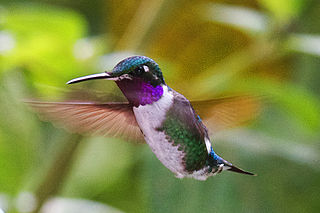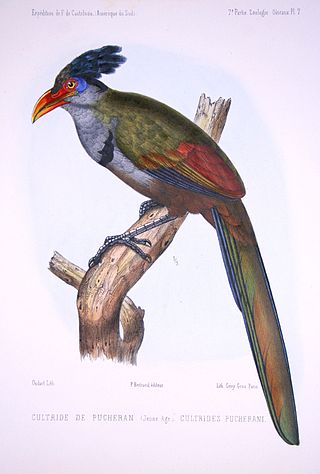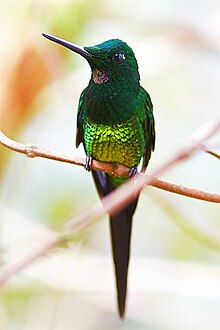
The green-crowned brilliant is species of hummingbird in the "brilliants", tribe Heliantheini in subfamily Lesbiinae. It is found in Colombia, Costa Rica, Ecuador, and Panama. It is also known as the green-fronted brilliant.

The colorful puffleg is an Endangered species of hummingbird in the "brilliants", tribe Heliantheini in subfamily Lesbiinae. It is endemic to Colombia.

The sapphire-spangled emerald is a species of hummingbird in the "emeralds", tribe Trochilini of subfamily Trochilinae. It is regularly found in Bolivia, Brazil, Peru, and Venezuela; as a vagrant in Argentina; and has possibly occurred in Ecuador.

The white-bellied woodstar is a species of hummingbird in tribe Mellisugini of subfamily Trochilinae, the "bee hummingbirds". It is found in Bolivia, Colombia, Ecuador, and Peru.

The glittering-bellied emerald is a species of hummingbird in the "emeralds", tribe Trochilini of subfamily Trochilinae. It is found in Argentina, Bolivia, Brazil, Paraguay, and Uruguay.

The golden-bellied starfrontlet is a species of hummingbird in the "brilliants", tribe Heliantheini in subfamily Lesbiinae. It is endemic to Colombia.

The rainbow starfrontlet is a species of hummingbird in the "brilliants", tribe Heliantheini in subfamily Lesbiinae. It is found in Ecuador and Peru.

The black-bellied thorntail is a species of hummingbird in the "coquettes", tribe Lesbiini of subfamily Lesbiinae. It is found in Bolivia, Brazil, Colombia, Ecuador, Peru, and Venezuela.

The rufous-webbed brilliant is a species of hummingbird in the "brilliants", tribe Heliantheini in subfamily Lesbiinae. It is endemic to Peru.

The pink-throated brilliant is a species of hummingbird in the "brilliants", tribe Heliantheini in subfamily Lesbiinae. It is found in Colombia, Ecuador, and Peru.

The violet-fronted brilliant is a species of hummingbird in the "brilliants", tribe Heliantheini in subfamily Lesbiinae. It is found Bolivia, Colombia, Ecuador, Peru, and Venezuela.

The black-throated brilliant is a species of hummingbird in the tribe Heliantheini or subfamily Lesbiinae. It lives in Brazil, Colombia, Ecuador and Peru.

The velvet-browed brilliant is a species of hummingbird in the "brilliants", tribe Heliantheini in subfamily Lesbiinae. It is found in Brazil, Guyana, Suriname, and Venezuela.

The stripe-breasted starthroat is a species of hummingbird in the "mountain gems", tribe Lampornithini in subfamily Trochilinae. It is endemic to Brazil.

The blue-headed sapphire or Gray's hummingbird is a species of hummingbird in the "emeralds", tribe Trochilini of subfamily Trochilinae. It is found in Colombia and Ecuador.

The dot-eared coquette is a species of hummingbird in the "coquettes", tribe Lesbiini of subfamily Lesbiinae. It is found in Bolivia and Brazil.

The red-billed ground cuckoo is a species of cuckoo in the tribe Neomorphini of subfamily Crotophaginae. It is found in Brazil, Colombia, Peru, and possibly Ecuador.

The crowned woodnymph or violet-crowned woodnymph is a species of hummingbird in the "emeralds", tribe Trochilini of subfamily Trochilinae. It is found from Belize and Guatemala to northern Peru.

The green-backed hillstar, formerly included in the white-tailed hillstar, is a species of hummingbird in the "brilliants", tribe Heliantheini in subfamily Lesbiinae. It is found in Colombia, Ecuador, and Peru.

The Perija starfrontlet is an Endangered species of hummingbird in the "brilliants", tribe Heliantheini in subfamily Lesbiinae. It is found in Colombia and Venezuela.






















